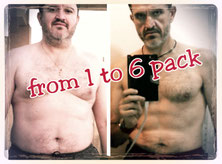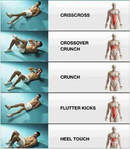
It will take dedication, time and patience to get a six pack. But all you need to do is only two things: lose weight and build abs muscle. You get this by kind of adopting a dieting and exercising philosophy consistently. You can have the most toned and muscular abs, but it will not show if there is a layer of fat over them. This blog will discuss the ways to accomplish the very first goal: weight loss.
Weight loss
First step is understanding what it means to lose weight. In order to burn fat, you need to use up calories. Since there are about 3,500 calories in a pound, you need to burn about 3,500 more calories than you bring in with food or drink in order to lose one pound. It sounds simple, but it's actually quite hard. Don't have unrealistic expectations. A vigorous, hour-long workout will only burn 800 - 1,000 calories.
Luckily, being active helps, and if you burn between 600 and 800 more calories than you take in per day, you can expect to lose about one pound per week. You'll start seeing results in your abs quite quickly. Understand this before you start trying to lose belly fat: There is no way to target fat loss in any one area of your body (This is also called "spot training.") Just like your body deposits fat in many different places, it burns fat in your entire body, not just from your abs or your thighs.
1. Do cardio workouts. You need to lose some of that extra fat over your abs. Even if you work out and get gigantic ab muscles, if there is still a layer of fat over them no one will ever get to see them. Cardio workouts are workouts that raise your heart rate for a given set of time. Some examples would be running, jogging, bike riding, dancing and rowing or even walking a bit fast. Try cardio workouts often (3 to 5 times per week) for at least an hour at a time or you can try walking 30mins daily. Simply go to your office or do your shopping walking. Try interval training. Interval training is short burst of furious activity followed by longer periods of low activity. Researchers think that interval training helps burn fat better than exercising at the same intensity for longer times: One study found that participants who practiced interval training on their bikes for only 20 minutes a day lost on average 4 more pounds, over 4 months, than participants who cycled at the same speed for 40 minutes a day.
2. Eat smaller meals late at night. Meals later on in the day tend to get stored as fat not because your metabolism is beginning to shut down, but because late-night meals are often overly caloric snack foods such as pizza or ice cream that aren't worked off before you go to bed. Your metabolism works even while you sleep; the fact is that most people eat sweets and starches before bed rather than kale and spinach. Try eating a larger lunch or snacking healthily before dinner. Fresh fruits or vegetables are excellent choices for curbing appetite while offering healthful benefits. A handful of nuts might do the same. Try drinking a large glass of water or tea right before sitting at the table. Your stomach will feel more full, allowing you to comfortably eat less.
3. Eat breakfast. Many people skip breakfast because they don't have time for it. The harm of skipping breakfast from a weight loss perspective is twofold: it causes you to get hungrier later on, and it fails to jump start your metabolism. Eating a healthy breakfast will keep you from eating more later on and put increase your resting metabolism by as much as 10% — for the rest of the day! Try eating lean protein in the morning. Skip the bagels and cream cheese. Instead, try: Egg-white omelet with spinach, turkey, and chipotle peppers. Greek yogurt with blueberries, bananas, and flax seed. Leftover salmon with whole-grain toast. Eat fruits and drink coffee or green tea (great to burn fats). Avoid eating: Sugary cereals. Simple starches such as potatoes (hash browns, etc.) and refined wheat (white bread, etc.). Smoothies. Low fat drinks don't always translate to lean physiques.
4. Lift weights. The more muscle your body has, the more calories your body burns, even at rest. Plus, resistance training is important to limit the amount of muscle mass lost whilst reducing your calorie intake. If you only do cardiovascular exercises (running, playing basketball, football) without weight training, you may lose the muscle mass, including the muscle in your abs.
5. Keep metabolism steady. While there isn't any scientific merit to the claim that eating six meals a day instead of three will help you lose weight, there are foods that you can eat that will slow down your metabolism. Avoid these foods to keep your metabolism steady: Refined carbohydrates, such as white bread, pasta, and rice. Sugar, which is absorbed quickly, but which brings your metabolism to a crawl. High-fat foods, such as fast food and fried food.
6. Drink more water every day. To find out how much water you need to drink as a minimum per day, halve your weight (in pounds) and that is how many ounces of water you need to drink. So a 150 lb person would need to drink a minimum of 2.2 liters a day. It sounds like an absurd amount of water, but you get water from the food you eat, and you can drink coffee or teas to make up some of the quota. Drinking too much water (several liters, especially while sweating) can dangerously dilute certain salts and minerals. If you are exercising heavily and sweating a lot, you will need to replace your salts as well as fluids. Supplement your water drinking with a sports drink or potassium rich fruits such as bananas and apples. Replace your water drinks for coffee or green tea will help you to burn calories faster.
7. Switch out refined grains for whole grains. In a scientific study, people who ate all whole grains (in addition to five servings of fruits and vegetables, three servings of low-fat dairy, and two servings of lean meat, fish, or poultry) lost more belly fat than another group that ate the same diet, but with all refined grains. A diet rich in whole grains changes the glucose and insulin response in your body, which hastens the burning of fat.
8. Get the right amount of sleep. Doctors are beginning to dive deeper into information suggesting that hormones that control appetite are affected by sleep, or lack thereof. In one study, scientists compared individuals who got 5.5 hours of sleep per night, and individuals who got 8.5 hours of sleep per night. The individuals who slept 8.5 hours per night were able to lose more body fat than those who slept only 5.5 hours per night.
9. Control your stress. Stress, along with sleep, is helpful in pushing you toward your weight-loss goal. Participants in a study who slept at least 6 hours but no more than 8, and who had the lowest levels of stress, were more likely to lose weight than participants who reported higher levels of stress.
Recommended articles










imp source (Thursday, 25 January 2018 11:33)
Big thanks to you for sharing such great information.
best fat burner (Saturday, 04 March 2017 00:46)
strict diets or starvation and steady workouts.
Cara cepat mengobati jumlah sel darah putih yang naik (Saturday, 09 January 2016 04:01)
thanks for his attentions, we like you article, dont forget share this article to other
Obat untuk kantung/buah zakar yang besar sebelah (Wednesday, 06 January 2016 03:41)
I agree with article you, Because it can giving information useful to companies. dont forget to share it to other again, thanks
Obat buah pelir kiri besar sebelah yang alami (Saturday, 26 December 2015 04:09)
thank you for visiting our website, may be useful and do not forget to help share
Cara menghilangkan flek hitam di wajah yang sulit hilang (Wednesday, 16 December 2015 07:19)
article you simply provide information, ask for permission to share, also visit our website
Obat Di Apotik (Friday, 16 October 2015 09:13)
thank you post articles that are very useful for me, hopefully in the future, better yet, do not forget to visit my site
Cara Mengobati Gatal Eksim di Selangkangan (Thursday, 08 October 2015 08:45)
I think your article is pretty good and really helped me in solving a problem, continue to increase again, and do not forget to visit our website :)
Obat Kulit Berair dan Ruam Merah di Tubuh (Wednesday, 30 September 2015 05:22)
article that you created quite so help me solve the problem, thank you for sharing to us all
Cara Menghaluskan Kaki yang Pecah Pecah (Tuesday, 29 September 2015 04:01)
we are expecting the next post can be loaded in detail in order to add aesthetics to the reader, but this time the articles I've read can also inspire me and add science to me
Obat Eksim pada Balita yang Alami dan Aman (Monday, 28 September 2015 06:00)
article that you create a very inspiring and as our solution solves the problem